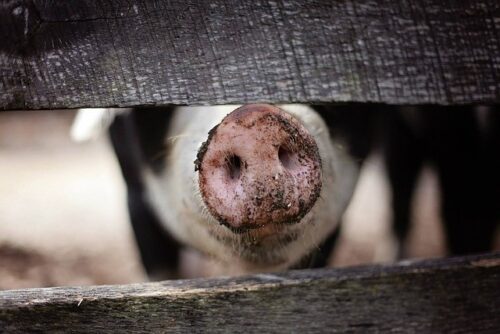CDC reports two human infections with swine flu viruses

By SDCN Editor
Washington, D.C.–The Centers for Diseases and Control and Prevention (CDC) this week reported the first two U.S. human infections with swine flu viruses in 2023.
The human infections were caused by two different types of flu viruses that normally spread among pigs, and they occurred in two people who attended different agricultural fairs in Michigan and had exposure to pigs.
The Michigan Department of Health and Human Services first reported a presumptive positive influenza A(H3) variant virus infection on July 26 in a person who attended a fair that took place July 7-16. A respiratory specimen from that patient was sent to CDC and received on July 27. Diagnostic testing conducted at CDC was inconclusive, likely due to the respiratory specimen not containing enough virus. However, it is likely the patient was infected with an influenza A(H3)v virus given the presumptive positive test results from Michigan, as well as the epidemiologic findings of the local investigation.
An investigation into this first infection found that the patient was exposed to pigs within 10 days prior to illness onset at an agricultural fair where swine influenza A virus was detected among pigs.
The patient was treated with flu antivirals and recovered from their illness.
The additional investigation did not identify respiratory illness in any of the patient’s close contacts or household contacts.
To date, no person-to-person spread of this virus has been identified.
The Michigan Department of Health and Human Services notified CDC of a specimen that tested positive for influenza A but lacked reactivity with diagnostic tests for contemporary human influenza viruses representing either H1pdm09 or H3 subtypes on July 31. A respiratory specimen from that patient was sent to CDC and received on August 2. This was confirmed at CDC to be an influenza A(H1N2)v virus infection. This occurred in a person who attended a different fair, which took place from July 23 to 29.
An investigation into the second infection found that the patient was exposed to pigs within 10 days prior to illness onset at another agricultural fair. The patient, who was not hospitalized, was treated with flu antivirals and is recovering from their illness.
The additional investigation did not identify respiratory illness in any of the patient’s close contacts or household contacts.
Agricultural fairs take place across the United States every year, primarily during the summer months and into early fall. Many fairs have swine exhibitions, where pigs from different places come into close contact with each other and with people. These venues can increase the risk that flu viruses will spread among pigs and between pigs and people. Infected pigs can cough or sneeze, and droplets with the virus in them can spread through the air. If these droplets land on a person’s nose or mouth or are inhaled, they can be infected. These infections have most commonly been reported after close proximity to infected pigs, such as in pig barns and livestock exhibits housing pigs at fairs.
Like flu viruses in humans and other animals, flu viruses found in pigs change constantly. Pigs can be infected by avian flu and human flu viruses as well as their own viruses. When flu viruses from different species infect pigs, the viruses can reassort (i.e., swap genes) and very rarely new viruses can emerge that can infect and spread from person to person. This is thought to have happened in 2009 when a new swine-origin H1N1 virus with genes of avian, swine, and human origin emerged to cause a flu pandemic.
The CDC recommends people take precautions to prevent the spread of swine influenza viruses to people and has guidance for people exhibiting pigs at fairs, people attending fairs, and fair organizers.
General precautions to limit the spread of flu viruses between people and pigs include not eating or drinking while in pig areas, avoiding contact with pigs that appear to be sick, and washing hands often with soap and running water before and after contact with pigs.
People at higher risk should avoid pigs and swine barns. If they cannot avoid exposure to pigs, they should wear a well-fitting face mask that covers the nose and mouth to reduce their risk of exposure to flu viruses.
People should take additional protective measures if they must come into contact with pigs that are known or suspected to be sick. This includes minimizing contact time with pigs and wearing personal protective equipment like protective clothing, gloves, and well-fitted masks that cover the mouth and nose when contact is required.
Human seasonal flu vaccines are not designed to protect against variant flu viruses, but the same flu antiviral drugs used to treat seasonal flu can be used to treat variant flu virus infection in children and adults.







